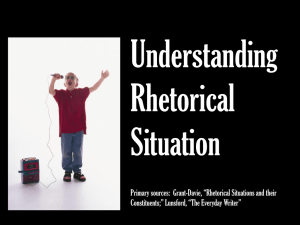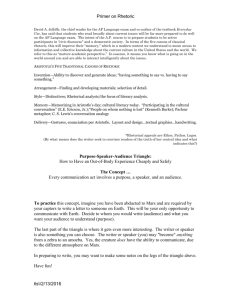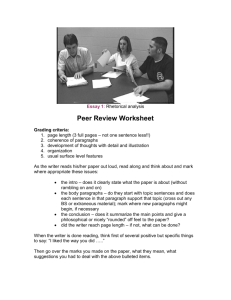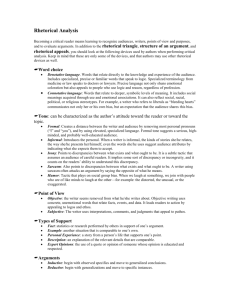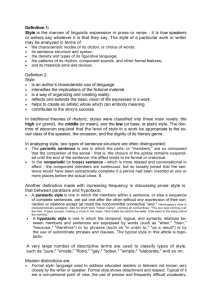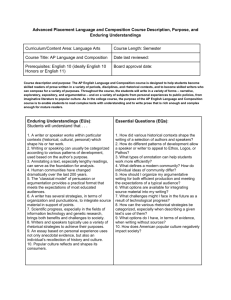Rhetorical Devices: AP English Language & Composition
advertisement
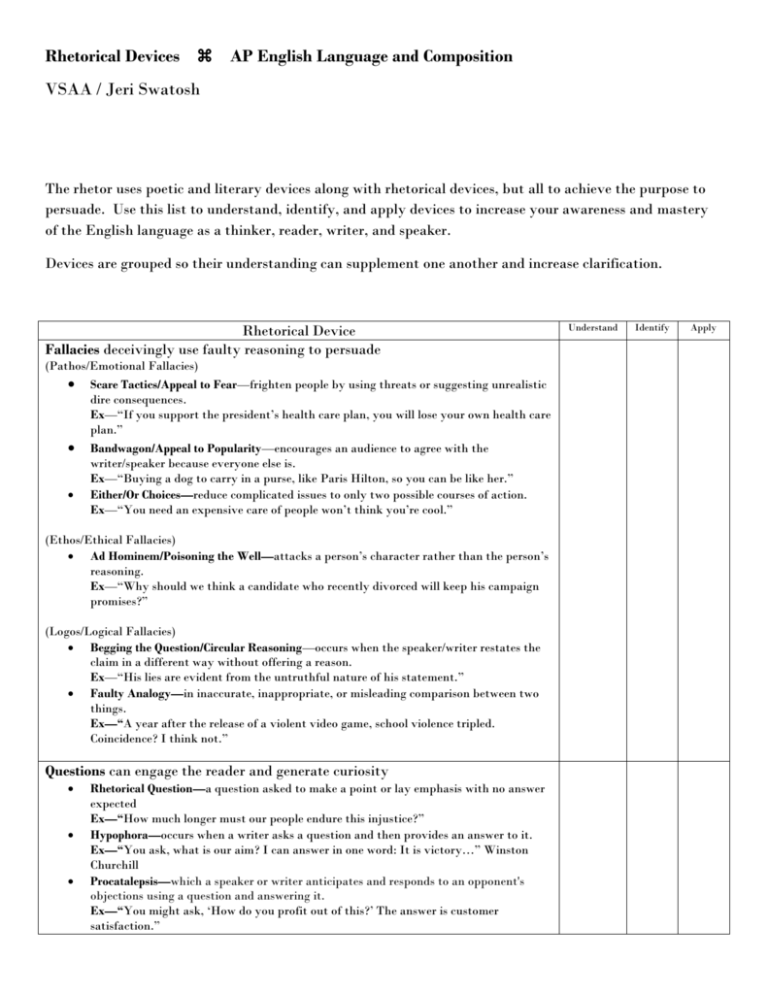
Rhetorical Devices AP English Language and Composition VSAA / Jeri Swatosh The rhetor uses poetic and literary devices along with rhetorical devices, but all to achieve the purpose to persuade. Use this list to understand, identify, and apply devices to increase your awareness and mastery of the English language as a thinker, reader, writer, and speaker. Devices are grouped so their understanding can supplement one another and increase clarification. Rhetorical Device Fallacies deceivingly use faulty reasoning to persuade (Pathos/Emotional Fallacies) Scare Tactics/Appeal to Fear—frighten people by using threats or suggesting unrealistic dire consequences. Ex—“If you support the president’s health care plan, you will lose your own health care plan.” Bandwagon/Appeal to Popularity—encourages an audience to agree with the writer/speaker because everyone else is. Ex—“Buying a dog to carry in a purse, like Paris Hilton, so you can be like her.” Either/Or Choices—reduce complicated issues to only two possible courses of action. Ex—“You need an expensive care of people won’t think you’re cool.” (Ethos/Ethical Fallacies) Ad Hominem/Poisoning the Well—attacks a person’s character rather than the person’s reasoning. Ex—“Why should we think a candidate who recently divorced will keep his campaign promises?” (Logos/Logical Fallacies) Begging the Question/Circular Reasoning—occurs when the speaker/writer restates the claim in a different way without offering a reason. Ex—“His lies are evident from the untruthful nature of his statement.” Faulty Analogy—in inaccurate, inappropriate, or misleading comparison between two things. Ex—“A year after the release of a violent video game, school violence tripled. Coincidence? I think not.” Questions can engage the reader and generate curiosity Rhetorical Question—a question asked to make a point or lay emphasis with no answer expected Ex—“How much longer must our people endure this injustice?” Hypophora—occurs when a writer asks a question and then provides an answer to it. Ex—“You ask, what is our aim? I can answer in one word: It is victory…” Winston Churchill Procatalepsis—which a speaker or writer anticipates and responds to an opponent's objections using a question and answering it. Ex—“You might ask, ‘How do you profit out of this?’ The answer is customer satisfaction.” Understand Identify Apply Repetition can increase attentiveness and assist memory Anaphora—repeats the same word or phrase at the beginning of successive clauses. Ex—“We shall fight in France, we shall fight on the season and oceans, we shall fight with growing confidence and growing strength in the air.” Epistrophe—(counter to anaphora)—repeats the same word or phrase at the end of successive clauses. Ex—“…and that government of the people, by the people, for the people, shall not perish from the earth.” Anadiplosis—repeats the last word or phrase of one line or clause to begin the next. Ex—“He speaks French as well. As well as your average parrot.” Commoratio—repeats a point several time but using different words/phrases. Ex—“This parrot is no more! It has ceased to be! It’s expired and gone to meet its maker.” Polyptoton—repeats words derived from the same root but with different endings. Ex—“Love is an irresistible desire to be irresistibly desired.” Pattern of Sounds are more subtle than repetition, but create a pattern that helps the reader/listener to remember an idea Amplification—happens when a writer makes a point twice in a row, with greater emphasis, details, or explanation the second time. Ex—MLK’s “America has given the negro people a bad check, a check which has come back marked ‘insufficient funds’ .” Isocolon—uses a succession of phrases of approximately equal length and corresponding structure. Ex—“The bigger they come, the harder they fall.” Tricolon—uses a series of three members. Ex—“A happy life is one spent in learning, earning, and yearning.” Pattern of Ideas are organizational devices Parallelism—is an important device that uses the same general structure for multiple parts of a sentence, or for multiple sentences, in order to link them all together. Ex—“The inherent vice of capitalism is the unequal sharing of blessing; the inherent virtue of socialism is the equal sharing of miseries.” Winston Churchill Ex—“He smiled happily and laughed joyfully.” Chiasmus—uses a special form of parallelism that flips the original form around. Ex—“He smiled happily and joyfully laughed.” (Use of verb/adverb to adverb/verb) Accumulation—gathers together disparate points into a thematic list. Ex—“A generation goes and a generation comes, yet the earth remains forever. The sun rises and the sun sets, and rushes back again to the place from which it rises. The wind blows south, then returns to the north, round and round goes the wind, on its rounds it circulates. All streams flow to the sea, yet the sea does not fill up." Ecclesiastes Auxesis—a form of hyperbole that shows a gradual increase in intensity of the meaning with words arranged in ascending order of force or importance. Ex—“Look! Up in the sky! It's a bird... it's a plane... it's Superman!" Climax—is a device that mounts by degrees through words or sentences of increasing weight and pin parallel construction. Ex—“I came, I saw, I conquered.” Opposites and Contradictions Antiphrasis—uses a word in a sense opposite to its conventional meaning. Ex—“How absolutely ravishing you look in orange and pink polyester!” Apophasis—raises an issue by claiming not to mention it. Ex—“Far be it from me to mention the motives of the noble lord.” Irony—Uses words to convey the opposite of their literal meaning. (Dramatic, situational, and verbal) Ex—“I posted a video on YouTube about how boring and useless YouTube is.” Litotes—expresses an affirmative by the negation of its opposite. Ex—“Your bedroom is not unclean.” Oxymoron—offers a conjunction of two contradictory terms. Ex—“I ate the jumbo shrimp and it was delicious.” Paradox—is a statement that appears to contradict itself. Ex—“The first shall be last and the last shall be first.” Malapropism—replaces an appropriate word by one with similar sound but inappropriate meaning. Ex—“He is the very pineapple of politeness.” Metaphor—is an implied comparison between two unlike things that have something in common. Ex—“Now is the winter of our discontent/ Made glorious summer by this son of York.” Simile—is a stated comparison between two fundamentally dissimilar things with some quality or qualities in common. Ex—“The harpsichord sounds like two skeletons jumping around on a corrugated tin roof.” Inclusion by Omission draws attention to an idea by denying it explanation or attention. Aposiopesis—is an unfinished thought or broken sentence. Ex—“If you don’t eat up that spinach, I’ll…” Ellipsis—is an omission of one of more words. Ex—“If only pigs could fly!” Paralepsis—emphasizes a point by seeming to pass over it. Ex—“Have patience, gentle friends, I must not read it. It is not meant you know how Caeser lov’d you.” Notes: This document is compiled from a variety of sources, including the instructor’s personal knowledge and experience. Check out virtualsalt.com and literarydevices.com for more information.
